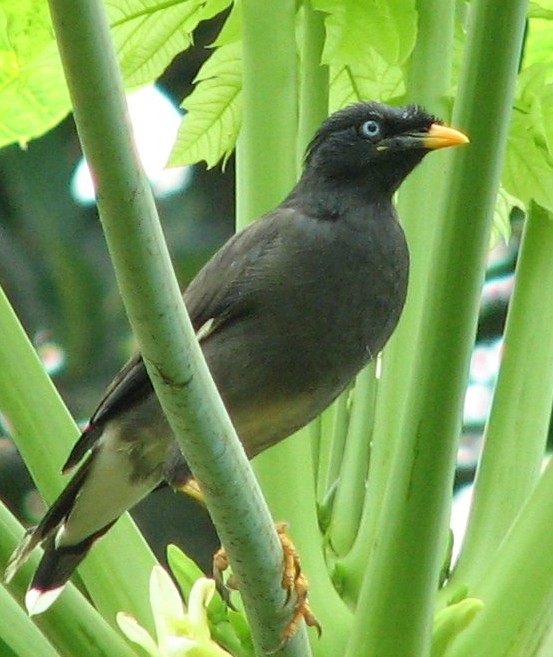Myna (Genus: Acridotheres) - Wiki Acridotheres
From Wikipedia, the free encyclopedia
Scientific classification
Kingdom: Animalia
Phylum: Chordata
Class: Aves
Order: Passeriformes
Family: Sturnidae
Genus: Acridotheres (Vieillot, 1816 )
[Photo] Acridotheres fuscus, Jungle myna of the south Indian race showing blue iris. Photograph by J. Sudheesh, Kottayam, Kerala 1 November 2005.
Acridotheres is a genus of starlings, the "typical" mynas (or mynahs), which are tropical members of the family Sturnidae. This genus has representatives in tropical southern Asia from Iran east to southern China and Indonesia. Two species have been introduced widely elsewhere. The Common Myna has been introduced to South Africa, Israel, Hawaii, North America, Australia and New Zealand, and the Crested Myna to the Vancouver region of British Columbia.
The Acridotheres mynas are generrally dark or dull birds with and fluted calls like most starlings; the sexes are similar. They walk rather than hop, and have modifications to the skull and its muscles for open bill probing. They resemble the hill mynas (Gracula) with which they often co-occur, in having large white or buff wing patches which are obvious in flight and in some also naked areas on the head, but differ in that only the head plumage is glossy, and the underparts tend to be paler. The naked head patches are different in arrangement. Acridotheres mynas are also much more terrestrial than Gracula.
They have bowing courtship displays, whereas Gracula has no visual display. They lay unmarked pale blue eggs.
Several species have frontal crests which become covered with pollen when the birds take nectar from flowers, and may play a role in pollination.
Like most starlings, the Acridotheres mynas are fairly omnivorous, eating fruit, nectar and insects.
Systematics
Despite being both called "mynas", the Acridotheres mynas are closer related to a group of mainly terrestrial starlings from Eurasia, such as the Common Starling, and also African ones like the Lamprotornis glossy-starlings. Among these, they are among the larger and duller species; they seem to be one of the major groups to evolve most recently. Apparently, they all arose from ancestors which arrived from Central Asia and adapted to more humid conditions in the Tropics. They presumably were isolated in about their current range when the evolutionary radiation to which they belonged - including the Wattled Starling and the Sturnia species - was fragmented by desertification of their of origin at the start of the Early Pliocene, as Earth turned towards the last ice age 5 million years ago.
The taxonomy of this group is complex, and other authorities differ considerably in which species they place in this genus, and in the species boundaries within Acridotheres.
The following is a list of "core" Acridotheres species in taxonomic order:
White-vented Myna, Acridotheres grandis
Crested Myna, Acridotheres cristatellus
Javan Myna, Acridotheres javanicus
Pale-bellied Myna, Acridotheres cinereus
Jungle Myna, Acridotheres fuscus
Collared Myna, Acridotheres albocinctus
Bank Myna, Acridotheres ginginianus
Common Myna, Acridotheres tristis
The taxonomy of this group is complex, and other authorities differ considerably in which species they place in this genus, and in the species boundaries within Acridotheres. Several species from the paraphyletic Sturnus assemblage are often placed in Acridotheres. Indeed, as more recent studies suggest (Jønsson & Fjelds?? 2006, Zuccon et al. 2006), this is most likely correct.
Vinous-breasted Starling, Sturnus burmannicus - alternatively united in Gracupica with Black-collared Starling
Asian Pied Starling, Sturnus contra
Black-winged Starling, Sturnus melanopterus
Red-billed Starling, Sturnus sericeus
White-cheeked Starling, Sturnus cineraceus
The last two are probably rather basal in the entire group and might even be closer to Sturnia. The relationships of the White-faced Starling are more unclear, but it is generally not held to be close to the present genus.
http://en.wikipedia.org/wiki/Acridotheres
| The text in this page is based on the copyrighted Wikipedia article shown in above URL. It is used under the GNU Free Documentation License. You may redistribute it, verbatim or modified, providing that you comply with the terms of the GFDL. |
